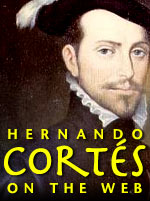
Primary Sources
Sources and methodology | Cortés | Bernal Díaz | Indigenous sources | De Las Casas | Others
Sources and methodology
The Conquest of Mexico by Nancy Fitch. There can be no quesiton but this is the best Cortés site on the web, my own site excepted, of course. It is an exceptional set of lesson plans, based around dozens of short extracts from primary sources, generally paired to bring two accounts side by side. Other exercises present pictures—from Aztec codices to Diego Rivera—and then actually ask interpretive questions about them. Fitch has really thought about how the web can (and can't) present primary sources.[1] There is an excellent Student's Introduction, explaining what she's up to.
"There are few 'facts' in these documents. They were put together to show you how "messy" history is, that what seems like 'facts' in textbooks were produced by interpreting documents which disagree."
"The Discursive Encounter of Spain and America: The Authority of Eyewitness Testimony in the Writing of History" by Rolena Adorno, The William and Mary Quarterly (April 1992). Academic essay investigates how conceptions of historical "authority" changed in the flurry of first and second-person accounts of conquest.
Overview of sources for the conquest of South and Central America, with much on the "ecclesiastic historians" (Bernadino de Sahagun, etc.) and the "native historians" available in English translations. The page is part of William M. Ringle Davidson University course Art, Myth and History of the Aztecs and their Neighbors.
Cortés
Excerpts from three sources on the conquest of Mexico:
- Hernan Cortés, Exerpt from Second Letter to Charles V (1520) — a very lengthy selection describing Tenochtitlan, from a 1907 translation.
- Aztec Account of the Conquest of Mexico, from The Broken Spears (1520s) — elsewere on the internet.
- Bartolome de Las Casas, from A Brief Account of the Devastation of the Indies (1542) — Actually covers Hispaniola, not Mexico
Moctezuma's Greeting to Hernan Cortés, excerpted from Anthony Pagden's translation of Cortés' letters.
Modern History Sourcebook: Hernan Cortés, from the Second Letter to Charles V (1520), scanned from Oliver J. Thatcher's 1907 The Library of Original Sources. Modernized by Prof. Arkenberg.
 Amazon. Letters from Mexico by Hernan Cortés (1986), translated by Anthony Pagden; see the
Yale UP blurb, with selections from highly-positive academic reviews.
Amazon. Letters from Mexico by Hernan Cortés (1986), translated by Anthony Pagden; see the
Yale UP blurb, with selections from highly-positive academic reviews.
"Cortés Describes Aztec Sacrifices, 1521" from Pagden's Letters From Mexico. Description of Aztec sacrifice, concluding with other sins-an interesting juxtaposition.
" For in addition to those which we list above, of the children and men and women which they kill and offer in their sacrifices, we have been informed, and are most certain it is true, that they are all sodomites and practice that abominable sin."
Web Archive: Cortés on the death of Moctezuma, from Augustus MacNutt's 1908 translation.
 Amazon. Five Letters:1519-1526 by Hernando Cortés, Bayard J. Morris.
Amazon. Five Letters:1519-1526 by Hernando Cortés, Bayard J. Morris.
Four 16th century pages related to Cortés. These include the title page of a 1524 Latin edition of two of the letters, a fine view of Tenochtitlan (possibly by D�rer), and other treats. The pages are from the "Promotion and Possession: New Spain" section of the UPenn online exhbit Cultural Readings: Colonization and Print in the Americas.
Short Cortés quotes with a Christian bent assembled for Jesus Christ Saves Ministries.
Bernal Díaz
 Amazon. The Discovery and Conquest of Mexico: 1517-1521 by Bernal Díaz Del Castillo.
Amazon. The Discovery and Conquest of Mexico: 1517-1521 by Bernal Díaz Del Castillo.
1911 Catholic Encyclopedia: Bernal Díaz del Castillo. Sympathetic.
Selection from Bernal Díaz on the marvels of Tenochtitlan.
Another selection from Bernal Díaz on Tenochtitlan (unknown translator)
"Some of the soldiers among us who had been in many parts of the world, in Constantinople, and all over Italy, and in Rome, said that so large a market place and so full of peo ple, and so well regulated and arranged, they had never be held before."
Reading questions on Bernal Díaz, from a University of Illinois Urbana course taught by Prof. Rolando J. Romero.
Brief selections from Díaz relative to this history of southern California, from Richard F. Pourade History of San Diego.
Cortés makes land and receives visitors, from Diaz.
Page from the first edition of Díaz's Historia Verdadera (1632—it didn't see print for a while), from the Promotion and Possession: New Spain section of the UPenn online exhbit Cultural Readings: Colonization and Print in the Americas.
"More honeymoon reading: The Conquest of New Spain" Review of Diaz from Shabbir J. Safdar's blog.
"It provides excellent detail, as Diaz was an experienced soldier and privy to most of the gossip in Cortés' camp. I highly recommend it, though you will find it has to be slogged through in places."
Quotes on chocolate including from Bernal Diaz.
Indigenous sources
 Amazon. The Broken Spears: The Aztec Account of the Conquest of Mexico by Miguel Leon-Portilla.
Amazon. The Broken Spears: The Aztec Account of the Conquest of Mexico by Miguel Leon-Portilla.
College-level reading section questions on The Broken Spears from a Brown University American history course taught by Karl Jacoby.
Modern History Sourcebook: Aztec Account of the Conquest of Mexico. Two passages from Miguel Leon-Portilla's The Broken Spears: The Aztec Account of the Conquest of Mexico (1962).
The Aztecs Speak: An Aztec account of the Conquest of Mexico by Shep Lenchek. Four-part source-based review of the conquest leaning heavily on Aztec acounts (from Leon-Portilla's The Broken Spears). Author explores how fortunate timing and peculiarities of Aztec religion helped Cortés. Commenting on the Aztec accounts, Lechek writes:
"What is most remarkable is that the Aztec account of the Conquest, is almost completely non-judgmental. Although they describe Spanish atrocities in gory detail, it is done factually, with little emotion. … Nowhere in the Aztec accounts of the Conquest do we find any effort to paint the Spaniards as monsters."Lenchek also has medium-length biographies of Cortés, Malinche (a biography/apologia), Jeronimo de Aguilar, and Moctezuma II .
"Teaching Latin American History" essay possibly by R. Douglas Cope and Thomas E. Skidmore, in conjunction with a 1992 Brown University course "1492: Encounter of Two Worlds." The author details the source-based pedagogy and surfaces an important issue about "indigenous" sources, like those in Broken Spears.
"An additional complication is that these texts are post-conquest. (For the pre-Columbian period proper, we used one of our few secondary sources, Eric Wolf's Sons of the Shaking Earth). How accurately do the selections in The Broken Spears, composed in the mid- sixteenth century, reflect native views at the time of the conquest? We did not budget enough classroom time to deal with such issues.The article includes the syllabus and some reading questions.
"The Fall of Tenochtitlan" (selection), from Leon-Portilla's The Broken Spears.
"How can we save our homes, my people?
The Aztecs are deserting the city:
the city is in flames, and all
is darkness and destruction."
Sheet from the Huejotzingo Codex (scroll down). The Huejotzingo Codex was prepared by the inhabitants of Huejotzingo for a petition against Spanish maladministration. Cortés initiated the suit for the inhabitants of Huejotzingo.
Amazon. Cantares Mexicanos: Songs of the Aztecs by John Bierhorst. Priced for libraries.
Encounter, The: A Time for Celebration? by Charles Weeks, Focus on the Humanities (July 1991). Article on the great issue of 1992: should the 500th anniversary of Columbus be celebrated or mourned? That's off-topic here—mercifully, there's so much of it!—but Weeks spends a paragraph on the Aztec sources book, Broken Spears:
"It is perhaps testimony to the success of the conquerors that little of this early material is readily available to readers today in satisfactory form. Unfortunately, Miguel León-Portilla's little book based on indigenous accounts and codex paintings, The Broken Spears: The Aztec Account of the Conquest of Mexico, falls short of being an adequate balance to Gómara's and other Spanish versions of the conquest."
"Invaders, Allies, God: Indigenous Mexican Views of the Spanish Invaders" by Christopher L. Bennett. Short college essay on indigenous views, here accessed via Leon-Portilla's The Broken Spears.
Aztec Religion and Nature by lay author Andreas Grünschloß. Includes two passages from Broken Spears, "A Song of Sorrow" and "The Fall of Tenochtitlan" and others from Bierhorst's Cantares Mexicanos.
De Las Casas
 Amazon. Short Account of the Destruction of the Indies by Bartolome De Las Casas (Penguin edition).
Amazon. Short Account of the Destruction of the Indies by Bartolome De Las Casas (Penguin edition).
Others
Bernardino de Sahag�n, Account of the massacre at the Feast of Uitzilopochtli, from a 1950 Utah UP edition I can't otherwise find.
A Spanish Painting of the Battle for Tenochtitlan (c. 1500) and An Aztec Painting of the Battle for Tenochtitlan (c. 1520)
Front page of López de Gómara's history (here in Italian).
Notes:
- See her
Reflective Essay. Read the whole essay, but I can't resist quoting—and not just a web snippet:
"Web readers do not like nor expect long linear texts like those found in printed books. This is evident in the summary Florence Baker of El Camino College provided on her students' reactions to my web-based materials. Some complained that it was 'too much text without images.' I have since incorporated more images, but the problem of the long unbroken text remains and, indeed, may be worse, as I tried to remain more faithful to the format of the nineteenth century source I translated. In reviewing on-line sources on using technology in teaching, I ran across an example of how to digitize effectively the Hippocratic Oath. Hyperlinks were used to break the document up into critical components, relegating background information to the background. The author also recommended using bullets to make the text more readable on the Web. But no one believes that Hippocratus. wrote with hyperlinks or bullets. Making a text more readable for the Web distorts it. Digitizing primary sources for online research and teaching, thus, immediately confronts the historian with the problem of preserving the full nature of the source while thinking about how different students are thinking and reading on-line."
She comments that the dislocation between printed and web material is not unique, giving epigraphy as an example. The texts and reading methods of Antiquity pose similar problems. Classicists know (and others generally disbelieve) that "silent reading" was virtually unknown to the Greeks and Romans—one well-known locus Classicus appears in Augustine's Confessions, where the young Augustine is astounded to find St. Ambrose reading without a sound coming from his mouth. The difficulty of dealing with unpunctuated texts without word divisions can be over-rated, but tables of contents, indices and other "metadata" were rare or unknown in Antiquity. Ancient plays did not even consistently indicate breaks between speakers! Fitch's frame-based comparisons—with a Spanish account in one frame, a Mexica account in the other—does, however, have a classical antecedent, Origen's Hexapla. (back)

All material © 2000–2005 Tim Spalding. Books presented in association with Amazon.com.
If you enjoy this site you may like these others by me:
Machu Picchu on the Web. More than 300 resources about the great "lost city" of the Incas.
Alexander the Great on the Web. Everything you ever wanted to know about Alexander, and pictures too.
Hieroglyphics! Comprehensive guide to Egyptian hieroglyphics.